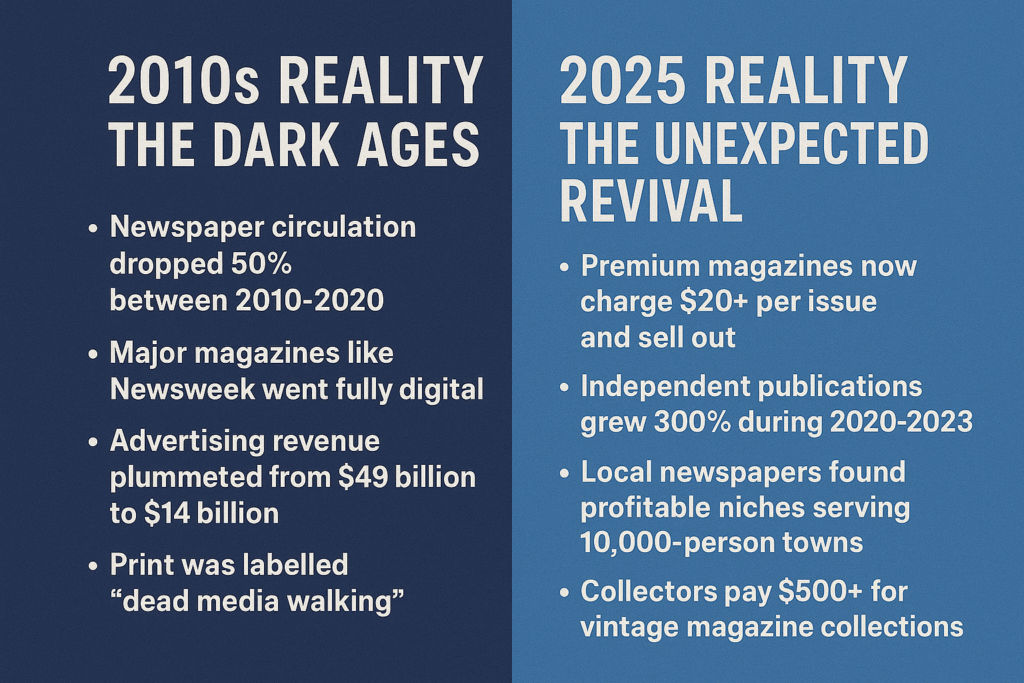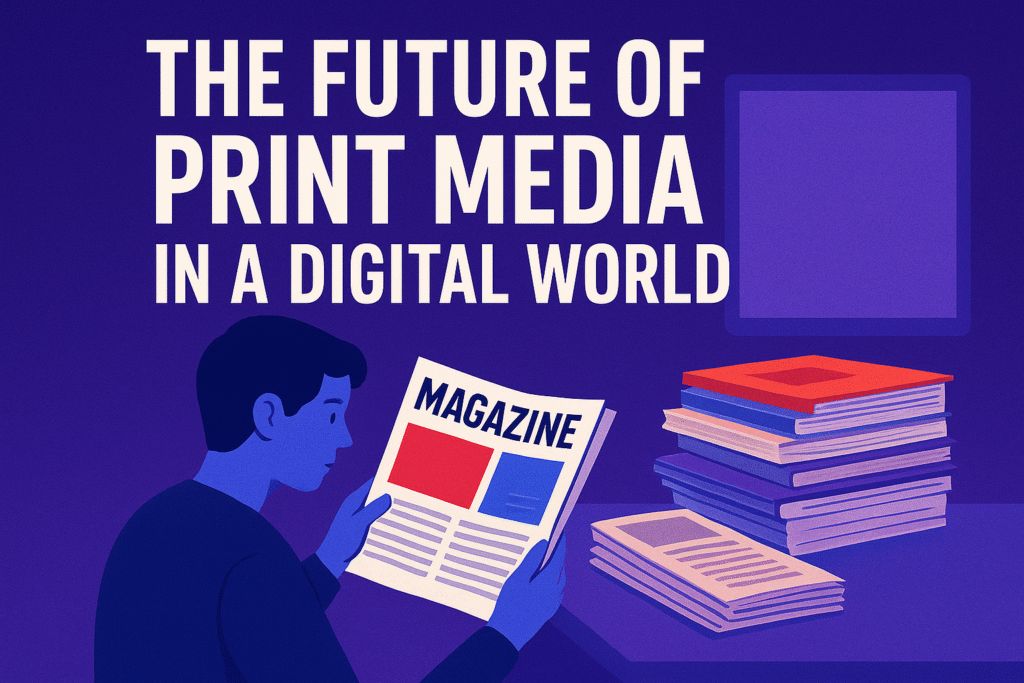When was the last time you held a magazine without immediately reaching for your phone? While experts predicted print media would be dead by 2020, the opposite happened. Let’s dive into why print media is making an epic comeback.
Table of Contents
What People Think Print Media Means
Most people picture outdated newspapers and dusty magazines when they hear “print media.” They imagine:
- Declining circulation numbers
- Expensive production costs
- Slow news delivery
- Environmental waste
- Old-fashioned reading habits
But here’s the reality: Modern print media includes luxury lifestyle magazines, artisanal zines, collectable publications, premium newsletters, and community-focused local papers that charge premium prices and create waiting lists.
Print media today isn’t about competing with Google News or social media feeds. It’s about offering something completely different – curated experiences, tactile luxury, and focused attention in our distracted world.
The Real Challenges Print Media Faces Today
Production and Distribution Costs
- Printing costs have increased by 40% since 2020 due to paper shortages
- Distribution networks shrank as newsstands closed
- Small print runs cost 3x more per unit than digital publishing
- Environmental regulations add 15% to production expenses
Changing Reader Habits
- The average reading attention span dropped from 12 minutes to 8 minutes
- 68% of people multitask while consuming media
- Instant gratification culture expects immediate updates
- Younger demographics grew up digital-first
Competition from Free Digital Content
- Google News aggregates content from thousands of sources
- Social media provides instant updates and commentary
- Streaming services offer unlimited entertainment options
- Free podcasts and YouTube channels cover every niche topic
Talent and Resource Drain
- Experienced journalists moved to digital platforms
- Advertising budgets shifted 80% toward digital channels
- Venture capital funding favours tech startups over media
- Skilled print designers command higher salaries
Why Print Media Remains Necessary
Credibility and Trust Factor
Print media goes through rigorous editorial processes that digital content often skips. Fact-checking, multiple editor reviews, and legal scrutiny create higher information quality. When Reuters published incorrect information online, they quickly corrected it. When The New York Times prints something, it carries legal and reputational weight that digital posts rarely match.
Deep Focus in a Distracted World
Human brains process printed information 21% faster than digital content. Without pop-up ads, notification alerts, or hyperlink distractions, readers can engage deeply with complex topics. Harvard Business Review’s print subscribers spend 45 minutes per article compared to 3 minutes for online readers.
Community Building and Local Connection
Digital platforms create global communities, but print media builds local bonds. Small-town newspapers cover city council meetings, high school sports, and local business openings that national digital media ignore. These publications become community gathering points that foster civic engagement and local identity.
Professional and Educational Value
Legal documents, academic research, and professional references still prefer print formats for permanence and authority. Courts accept printed evidence more readily than digital files. Students retain information 42% better from printed textbooks compared to e-books, making print essential for serious learning.
Economic Impact on Local Communities
Print media creates jobs that can’t be outsourced – local reporters, photographers, printing press operators, and delivery drivers. When a local newspaper closes, studies show property values drop 2.3% and municipal borrowing costs increase by 11 basis points because civic oversight disappears.
The Great Print Media Transformation: Then vs Now

2010s Reality: The Dark Ages
- Newspaper circulation dropped 50% between 2010-2020
- Major magazines like Newsweek went fully digital
- Advertising revenue plummeted from $49 billion to $14 billion
- Print was labelled “dead media walking”
2025 Reality: The Unexpected Revival
- Premium magazines now charge $20+ per issue and sell out
- Independent publications grew 300% during 2020-2023
- Local newspapers found profitable niches serving 10,000-person towns
- Collectors pay $500+ for vintage magazine collections
The shift wasn’t about survival—it was about reinvention.
Case Study 1: Monocle Magazine’s $50 Million Success
Tyler Brûlé’s Monocle proved print could thrive by doing the impossible: charging premium prices during a recession. Here’s their winning formula:
The Strategy:
- Thick, expensive paper that feels luxurious
- $15 per issue when competitors charged $5
- Limited distribution creates scarcity
- Zero digital advertising—print revenue only
The Results:
- $50 million annual revenue by 2023
- 80,000 loyal subscribers worldwide
- Waiting lists for back issues
- Expansion into cafes, hotels, and retail
Why It Worked: Monocle treated print as a luxury good, not cheap information. Readers bought status and experience, not just articles.
Case Study 2: The Local News Goldmine
The Storm Lake Times in Iowa (population 10,600) won a Pulitzer Prize and became profitable when bigger papers failed. Their secret weapon:
What They Did:
- Hyperlocal coverage nobody else provided
- $300 wedding announcements (people paid happily)
- Local business partnerships are worth $200K annually
- Community events generating $50K+ yearly
The Impact:
- Subscription revenue has increased 400% since 2018
- Digital subscriptions from former residents worldwide
- The town’s economic development improved measurably
The Lesson: Print media wins when it serves communities that digital platforms ignore.
Case Study 3: Fantastic Man’s Fashion Revolution
This Dutch men’s magazine revolutionised fashion publishing through radical print innovation:
The Innovation:
- Released only twice yearly
- Each issue is treated like an art book
- $40 per copy, limited to 50,000 copies
- Zero online content—print exclusive
The Success:
- Sold out within weeks of each release
- Influenced major fashion brands’ marketing
- Spawned copycat publications worldwide
- Became collectable items on eBay
The Breakthrough: They proved print could be event-driven rather than schedule-driven.
The Psychology Revolution: Why Brains Crave Print
Digital Fatigue is Real
- The average person checks their phone 96 times daily
- Reading comprehension drops 20% on screens
- Blue light disrupts sleep patterns for 67% of users
- Information overload affects 73% of digital readers
Print Provides Mental Relief
- No notifications interrupting focus
- Better memory retention (42% higher than digital)
- Reduces stress hormones by 30%
- Creates “mindful reading” experiences
The Trust Factor
- 76% trust print news more than digital news
- Physical publications seem more credible
- Premium feel suggests quality content
- Readers invest more attention in paid content
Future Trends That Will Transform Print Media
1. Smart Paper Technology: E-ink displays embedded in traditional paper will create dynamic content that updates while maintaining print’s tactile benefits.
2. Ultra-Personalisation: AI-driven printing will create custom magazines for individual readers, combining mass production with personal relevance.
3. Subscription Box Revolution: Curated print experiences delivered monthly will replace traditional newsstand sales, creating anticipation and discovery.
4. Event-Driven Publishing: Publications will launch around major events, trends, or cultural moments rather than following fixed schedules.
5. Environmental Premium: Carbon-negative printing using algae-based inks will appeal to eco-conscious consumers willing to pay 40% more.
The Revenue Revolution: New Money Models
Beyond Advertising: Diversified Income
- Event hosting: $100K+ annually for mid-size magazines
- E-commerce: 30% profit margins on curated products
- Consulting: Expertise monetisation worth $200K yearly
- Membership programs: $50-500 monthly fees
Case Example: Kinfolk Magazine’s Empire started as a quarterly lifestyle publication, and now generates $10M+ annually through:
- Print magazine sales: $2M
- Online courses: $3M
- Branded events: $2M
- Product collaborations: $3M
Technology Integration That Works
QR Codes 2.0
- Augmented reality experiences
- Exclusive video content access
- Direct purchasing from ads
- Social media integration
Hybrid Experiences
- Print anchors, digital extends
- Podcast series linked to articles
- Online communities for subscribers
- App-based reader rewards
Data-Driven Content
- Reader behaviour analytics
- Content optimisation based on engagement
- Personalised future issues
- Targeted advertising integration
The Generational Surprise: Gen Z Loves Print
Unexpected Statistics:
- 73% of Gen Z bought print magazines in 2024
- Independent bookstore sales up 65% among the 18-25 age group
- Vintage magazine collecting became a TikTok trend
- Print subscription gifts increased by 200% for young adults
Why Gen Z Chooses Print:
- Instagram-worthy aesthetic value
- Breaks from screen time
- Collectable and shareable
- Supports favourite creators directly
Global Success Stories Prove Print’s Power
Japan’s Magazine Culture
- 3,000+ magazine titles still profitable
- Convenience store magazine sales: $2 billion annually
- Speciality hobby magazines charge $30+ per issue
Germany’s Newspaper Resilience
- Local papers maintained 85% of pre-digital circulation
- Government subsidies supported quality journalism
- Community engagement programs generated additional revenue
India’s Publishing Boom
- Regional language publications growing 15% yearly
- Rural areas prefer print for reliability
- Mobile phone integration increased readership 300%
Actionable Strategies for Print Success Today
For Publishers:
- Focus on experiences, not just information
- Create scarcity through limited editions
- Build communities around content
- Integrate digital tools strategically
- Diversify revenue beyond subscriptions
For Advertisers:
- Use print for premium brand positioning
- Create tactile, interactive ad experiences
- Target affluent, engaged demographics
- Measure brand lift, not just reach
- Combine print campaigns with digital follow-up
For Content Creators:
- Develop print-specific content formats
- Leverage print’s credibility factor
- Create collectable, shareable pieces
- Build direct reader relationships
- Use print as a portfolio enhancement
The Bottom Line: Print’s Profitable Future
Print media isn’t competing with digital—it’s complementing it. Smart publishers understand that different formats serve different needs:
- Digital: Breaking news, updates, convenience
- Print: Deep dives, luxury experiences, focused attention
The future belongs to media companies that master both worlds, using each format’s strengths strategically.
Frequently Asked Questions
Is print media actually profitable in 2025?
Yes, when done right. Premium publications, local newspapers, and niche magazines are generating significant profits by focusing on quality over quantity and charging appropriate prices for their value.
What makes modern print different from traditional publishing?
Modern print emphasises experience over information, uses technology integration wisely, diversifies revenue streams, and treats publications as luxury items rather than commodities.
How can new publishers break into the print market?
Start with a specific niche, focus on community building, create premium experiences worth paying for, and use digital tools to enhance rather than replace print offerings.
Will younger generations continue buying print media?
Surprisingly, yes. Gen Z is driving much of the current print revival, viewing physical publications as collectable, Instagram-worthy, and a healthy break from digital overload.
What’s the biggest mistake print publishers make today?
Trying to compete with digital on speed and convenience instead of leveraging print’s unique advantages: focus, luxury, credibility, and tactile experience.
The print media revolution is happening now. Publishers who understand this shift are building sustainable, profitable businesses, while others struggle with outdated models. The question isn’t whether print will survive—it’s whether you’ll capitalise on its transformation.
Ready to join the print media comeback? Start by identifying what unique value only physical publications can provide your audience, then build your strategy around that irreplaceable advantage.
